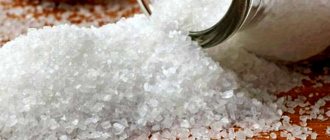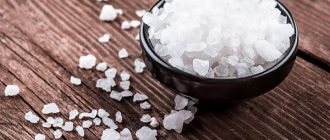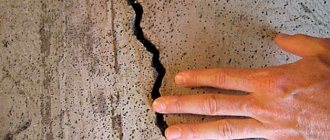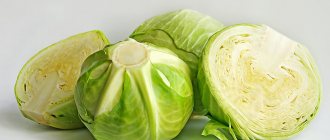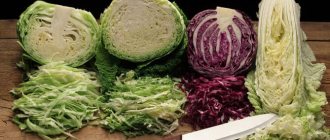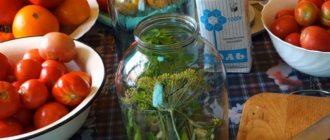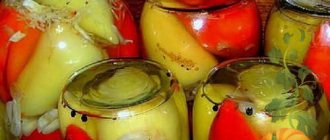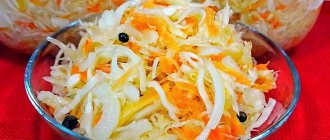The importance of choosing the right salt for pickling cabbage
The quality of sauerkraut is influenced by its type and variety . Depending on these characteristics, the fermentation process occurs differently.
If you choose the “wrong” salt, the product turns out to be peroxided , the leaves become soft and unsuitable for consumption.
When purchasing a product, look at the packaging:
- Name;
- mode of production;
- variety;
- grind number;
- what is it enriched with;
- additives;
- recommendations for use;
- manufacturer's name.
Take note:
Delicious recipes for sauerkraut with apples for the winter
Delicious sauerkraut recipes without added sugar
Simple, quick and tasty recipes for pickling cabbage for the winter
Small or large?
Already when describing the types of salt, it was mentioned that it can be of different grinds. Particle size is really important for pickling and preservation. Coarse table salt is traditionally considered the best option for home preparation. Let's try to understand why this happens using specific examples.
By the way, if you are interested in reliable recipes for pickled tomatoes, look for them in our article.
Another reason to use coarse or medium salt is that this is what all recipes are aimed at. If you prefer fine grinding, there is a risk of incorrectly calculating the proportions and over-salting.
Selecting the type of salt
The quality of the future workpiece depends on the type of product.
Food
Cooked food - mineral substance . In appearance - white or transparent crystals, odorless, but with a pronounced taste.
Salt - sodium chloride : Na - 39.4%, CI - 60.0%.
Chemical composition of table salt (per 100 g):
- potassium - 9 mg;
- calcium - 368 mg;
- magnesium - 22 mg;
- sodium - 38710 mg;
- sulfur - 180 mg;
- phosphorus - 75 mg;
- chlorine - 59690 mg;
- iron - 2.9 mg;
- cobalt - 15 mcg;
- manganese - 0.25 mg;
- copper - 271 mcg;
- molybdenum - 110 mcg;
- selenium - 0.1 mcg;
- fluorine - 2 mcg;
- zinc - 0.6 mg.
By origin and method of extraction:
- Stone . They are mined in mines and quarries. Contains few impurities, up to 99% sodium chloride. Has low humidity.
- Evaporation . Natural or artificial brines are evaporated. Natural ones are extracted from the ground, artificial ones are obtained by dissolving rock salt in wells. It is characterized by low hygroscopicity, high sodium chloride content, and a small amount of impurities.
- Self-planting . Ozernaya, it is mined from the bottom of salt lakes. Precipitated, it forms layers. Natural impurities - silt, sand, clay - give the color a yellow, gray tint. Characterized by high humidity.
- Sadochnaya . Extracted from the water of oceans and seas. Water is diverted into large but shallow artificial pools. Natural evaporation occurs and salt precipitates. Sadochnaya has many shades due to the large number of impurities.
According to GOST 51574-2000, table food is divided into four grades depending on the purity of the product , elements of the chemical composition, and particle size:
- Extra. The product is white, without impurities. Particle size within 0.8 mm.
- Higher. Pure white crystals up to 1.2 mm in size.
- First. Grayish grains up to 4 mm. In addition to sodium chloride, it may contain other minerals.
- Second. The composition is closest to natural.
The normal salt intake for humans is 11-15 g per day.
Benefits of consuming table salt:
- has a rich mineral composition;
- has antiseptic properties;
- adds flavor to dishes and acts as a flavor enhancer.
Disadvantage : an excess leads to the development of diseases of the cardiovascular system and gastrointestinal tract.
Marine
Salt obtained through the natural process of “evaporation” from the sea is called sea salt.
Interesting! The marine product has been mined for over 4,000 years.
Chemical composition (per 100 g):
- potassium - 9 mg;
- calcium - 368 mg;
- magnesium - 22 mg;
- sodium - 38710 mg;
- sulfur - 180 mg;
- phosphorus - 75 mg;
- chlorine - 59690 mg;
- iron - 2.9 mg;
- cobalt - 15 mcg;
- manganese - 0.25 mg;
- copper - 271 mcg;
- molybdenum - 110 mcg;
- zinc - 0.6 mg.
Real sea salt is black, yellow or pink . Bleached does not have beneficial qualities.
Characteristics of sea salt:
- has a rich mineral composition;
- used in the food, chemical industry, medicine;
- The iodine included in the composition does not lose its beneficial properties over time.
When preparing dishes, it is recommended to replace table food with sea food - the body will receive more useful microelements.
Iodized
Iodized is a type of table salt to which iodide and potassium iodate have been artificially added . This variety appeared in the 60s of the 20th century.
Chemical composition (per 100 g):
- calcium - 368 mg;
- magnesium - 22 mg;
- sodium - 38710 mg;
- potassium - 9 mg;
- phosphorus - 75 mg;
- chlorine - 59690 mg;
- sulfur - 180 mg;
- iron - 2.9 mg;
- zinc - 0.6 mg;
- iodine - 4000 mg;
- copper - 271 mg;
- manganese - 0.25 mg;
- cobalt - 0.015 mg.
Inexperienced housewives often wonder whether it is possible to ferment, pickle, or pickle cabbage with iodized salt . The answer is no. Lactic acid bacteria do not multiply with a large amount of iodine, and the fermentation process is disrupted. The cabbage turns out slimy and not crispy. Over time, this leads to damage to the workpiece.
Benefits of Iodized Salt:
- saturates the body with iodine;
- participates in the prevention of thyroid diseases.
Flaws:
- evaporates completely at high temperatures;
- cannot be used for pickling.
Salt with exotic notes
It turns out that salt comes in the most unexpected colors, such as black, pink or red. This color effect is caused by impurities. For example, red Hawaiian salt is colored by clay from the veins between solidified lava flows. This salt is rich in iron and has a mild taste with sweetish, nutty notes. It looks especially interesting on dishes with a similar color scheme: salmon steak or red grapefruit. The exotic nature affects the price: 1 kg of such salt can cost the buyer 600 rubles.
Pink Himalayan salt is a coarse mineral salt whose color is due to the presence of impurities of potassium chloride and iron oxide. This salt is mined in large blocks, which are then cut out, in the spurs of the Himalayas, in Pakistan and India. It is used mainly at the final stage of preparing dishes, as well as for decorating them. By the way, salt blocks are even used for interior work. The price of pink salt varies from 500 to 1,600 rubles per kilogram.
Black salt is also mined in the Himalayas. The iron sulfite it contains gives the salt a dark brown-violet color, and the sulfur compounds give it the smell of hydrogen sulfide. For Russians, the smell of black Himalayan salt is often too strong. A kilogram of salt can be purchased for about 750 rubles.
“Salt flower”, or fleur de sel, is salt that is collected by hand in France from ponds with sea water, where even in a good season only a few tons come out, which determines the high price: a kilogram of such salt can cost more than 3,500 rubles . Crystals form on the surface of the water and look like the first snow. In some parts of the ponds, it is not white salt that is collected, but the grayish salt most valued by connoisseurs, with inclusions of clay particles and special algae from these ponds.
A type of salt called algal salt appeared. Manufacturers claim that this is a natural substitute for regular salt, made from ground dried White Sea algae - kelp and fucus. In fact, this is the long-familiar and familiar seaweed from a new perspective. It is proposed to salt dishes not with ordinary salt, but with this powder. The price per kilogram is from 750 rubles.
Kosher salt is nothing more than rock salt that is usually made without the use of any additives. It is called that because it is used for koshering meat, that is, rubbing the carcass to remove residual blood. Its difference from ordinary salt is the large size of the granules and the flat or pyramidal shape of the crystals. Many chefs and professional bartenders value it because its shape allows it to adhere better to various surfaces, be it fish or a margarita glass. The price of a kilogram of salt for kosher is about 700 rubles.
Truffle salt was invented for gourmet food. Unbleached sea salt adds 5-6% black or white truffle, which gives it a distinct, distinctive aroma. Of course, they don’t buy this salt in kilograms; they usually take 30 or 100 grams, because a kilo costs more than 16,000 rubles.
New to the market is smoked salt. Touted as a natural flavor enhancer. When obtaining such a product, so that the crystals are saturated with the natural aroma of smoked meats, the salt is smoked over wood smoke. The most common options for smoking salt are with alder, apple, oak and juniper. The price per kilogram is about 1,000 rubles.
Grind Selection
Salt can be finely or coarsely ground. The size of the salt affects the fermentation process . The grind number is indicated for the highest, first and second grades.
| Grind no. | Crystal size | Content of large crystals |
| 0 | up to 1.2 mm | no more than 10% |
| 1 | from 1.2 mm to 2.5 mm | no more than 3% |
| 2 | from 2.5 mm to 4 mm | no more than 5% |
| 3 | from 4 mm | 15% |
Large/stone
Refers to sedimentary minerals . Consists of sodium chloride and impurities. In nature it looks like a stone. After processing and purification, it takes on the appearance of familiar salt.
In its natural form it happens:
- transparent;
- opaque but translucent;
- white with a glassy sheen.
Reference. Large deposits of rock salt in Russia are Solikamskoye, Iletskoye, Irkutskoye.
Depending on the deposit, the composition of impurities is different , therefore the color of the substance is different:
- iron oxide - yellow, red;
- decomposed organic matter - from dark brown to black;
- clay - gray;
- potassium chloride - blue, lilac.
What salt should I use for canning cucumbers?
Each type has its own characteristics. In order to figure out the problem yourself, you should make several jars of pickles, where different pickling options were used.
Then you will need to compare the results and choose the one that is most suitable.
See also
How to salt volushki in jars at home using cold and hot methodsRead
Algorithm for proper salting
Stages of proper salting:
- They take late varieties of cabbage - it is distinguished by crispy, juicy leaves and strong heads.
- The forks are cleared of the upper leaves, cut into two parts, and the stalk is removed.
- If the cabbage is clean, without insects or signs of rotting, then it is shredded.
- If small insects are found inside, the head of cabbage is divided into leaves and washed under running water. Another way is to immerse the halves of a head of cabbage in salted water for 2-3 minutes.
- Carrots are washed, peeled and grated on a coarse grater.
- Mix vegetables in a large wide container.
- Mash until the first juice comes out.
- Add salt and stir.
- They place the load.
At room temperature, cabbage ferments for 3-4 days . Every day the mass is pierced with a wooden stick in several places to release carbon dioxide and the foam is removed. It is the presence of foam on the surface that tells you that it’s time to pierce the cabbage.
The finished product is transferred to clean and dry glass jars . Place in a cool place.
How does salt affect the taste of canned food?
Since ancient times, ordinary crystals without any additives have been used for pickling vegetables. It is difficult for a modern person to understand the processes of product production. But you need to know that there are different types of grinding. Small crystals penetrate the fruits faster, speeding up the pickling process. And this does not always have a positive effect on the taste of cucumbers or tomatoes. It is better when vegetables are salted slowly. This is how they retain their beneficial qualities. Therefore, it is worth paying attention to coarse grinding.
Why is sea salt so popular?
It is traditionally believed that sea salt contains all the benefits of sea water. At the same time, sea salt owes much of its popularity to the excellent work of marketers and romantically minded consumers. Of course, salting food with sea salt is much more interesting: mermaids, the king of the sea, the secrets of the ocean and all that. What is one “flower of salt” worth - salt crystals collected by hand on the oceanic coasts of France. Fairy tale! Regular table salt seems so prosaic against this background. Sea salt is also often sold in the form of mixtures with herbs, pepper, garlic, lemon zest, colored with wine, flavored with lavender, dill and even truffles. Who can resist such beauty?
On the other hand, this should please: those who prefer sea salt are not alien to aesthetics and a craving for beauty. But you need to keep in mind that sea salt is not a food, but a seasoning, and try to comply with the daily intake of this product recommended by experts. Microelements need to be obtained not only and not so much from salt, but from fruits, meat and vegetables. And sea salt, if you like it so much, let it be: it’s quite suitable for adding salt to already prepared dishes.
Is it possible to preserve cucumbers with iodized salt?
Deputies' proposals to sell only iodized salt leave housewives in shock: will it be possible to pickle cucumbers or not? The production of iodized products has changed, so there is no need to be afraid that cucumbers will spoil or taste bad. Nowadays, crystals are not enriched with sodium thiosulfate. Changes in the enrichment of crystals have led to the fact that it is possible to use an iodized product when pickling cucumbers. It will not affect the appearance, taste and preservation of preserved food for the winter.
Source
